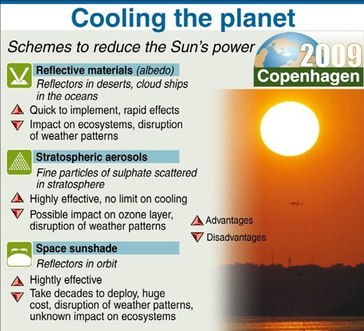Climate: Could 'Dr. Strangelove' Idea Be an Option?

A controversial idea to brake global warming, first floated by the father of the hydrogen bomb, is affordable and technically feasible, but its environmental impact remains unknown, a trio of U.S. scientists say.
Sowing the stratosphere with particles to reflect the Sun and cool the planet is possible with current technology and would cost a fraction of the bill from climate change or reducing emissions by fossil fuels, they argue.
Back in 1997, as man-made global warming became a political issue, U.S. nuclear physicist Edward Teller and others suggested spreading sulphate particles into the upper atmosphere.
Carried around the globe on high-speed winds, the whitish particulates, known as aerosols, would reflect the Sun, reducing solar radiation by around one percent.
It would provide a cooling similar to when volcanoes spew out clouds of dust, said Teller, who argued this option was far smarter than switching out of cheap and dependable fossil fuels.
Teller, a hawk on nuclear weapons who reputedly inspired the movie character Dr. Strangelove, was lashed for an idea that critics said was unworkable and laden with risk.
The new study, published in the British journal Environmental Research Letters, makes a cost analysis of so-called solar radiation management, or SRM, by aerosols.
In itself, the publication shows scientists' growing interest in examining -- if not endorsing -- once-mocked options as carbon emissions bust new records and political solutions lie beyond the horizon.
The study says the basic technology to distribute the aerosols exists and could be implemented for less than $5 billion (four billion euros) a year.
By comparison, the cost of reducing carbon dioxide (CO2) emissions to safer levels is estimated at between 0.2 and 2.5 percent of world gross domestic product (GDP) in 2030, roughly equivalent to $200 billion to $2,000 billion (160 to 1,600 billion euros), it says.
"We think this work demonstrates that it (SRM) is feasible by showing that several independent options can transport the required material at a cost that is less than one percent of climate damages or the cost of mitigation," says the paper, headed by Jay Apt, a professor at the Department of Engineering and Public Policy at Carnegie Mellon University in Pennsylvania.
"Removing this uncertainty is relevant whatever one's view about implementation of SRM."
The probe estimated costs of systems that would deliver one million tons of particles each year at a height of 18-25 kilometers (11.25-15.6 miles) in a latitude range of 30 degrees north and 30 degrees south.
The best option would be to develop specialized aircraft, as current airliners cannot fly at such attitudes. Airships would be cheaper but their bulk would make them vulnerable to jetstream winds.
Other options included guns to fire particle-stuffed shells into the atmosphere and a 20-km (12-mile) -high pipe, suspended by helium-filled floating platforms, to disgorge a particulate stream.
Compared to aircraft, though, the technology was either underpowered, too costly or too hypothetical.
The investigators stress they did not look at environmental risk or problems of governance and warn SRM can only be implemented when these and other questions are answered.
In a 2009 overview of geo-engineering, Britain's prestigious Royal Society said aerosols could be deployed quickly and could start reducing temperatures within a year.
But, it warned, they would not stop the buildup of atmospheric CO2, which is leading to dangerous acidification of the oceans. There could also be an impact on Earth's ozone layer and on regional rainfall patterns.
In July, German researchers reported on another geo-engineering idea -- of fertilizing the sea with iron particles so that the plankton sucks up CO2, eventually storing the carbon on the seabed when it dies and falls to the depths.
The scheme did work in particular conditions of a swirling Antarctica eddy, but further work is needed to see what happens in conditions with sideways currents, they said. The German experiment did not look at the environmental impact.



